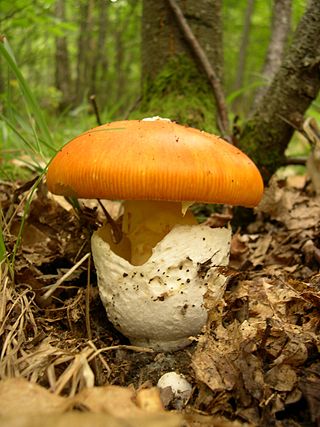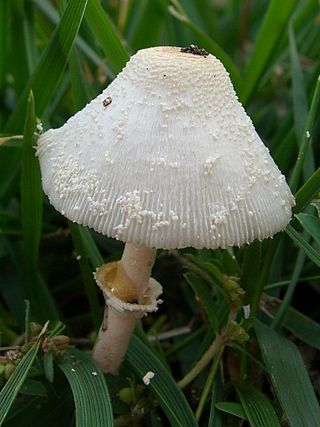
In mycology, a volva is a cup-like structure at the base of a mushroom that is a remnant of the universal veil, or the remains of the peridium that encloses the immature fruit bodies of gasteroid fungi. This macrofeature is important in wild mushroom identification because it is an easily observed, taxonomically significant feature that frequently signifies a member of Amanitaceae. This has particular importance due to the disproportionately high number of deadly poisonous species contained within that family.

Leucocoprinus cepistipes, is a species of fungus in the family Agaricaceae. It is typically found on wood debris, such as wood chips but may also grow in potted plants or greenhouses. Typical characteristics include a fine-scaled bell-shaped cap, a partial veil, and a tendency to bruise a yellow to brown when handled.

Amanita abrupta, commonly known as the American abrupt-bulbed amanita or the American abrupt-bulbed lepidella, is a possibly toxic species of fungus in the family Amanitaceae. Named for the characteristic shape of its fruit bodies, this white Amanita has a slender stem, a cap covered with conical white warts, and an "abruptly enlarged" swollen base. This terrestrial species grows in mixed woods in eastern North America and eastern Asia, where it is thought to exist in a mycorrhizal relationship with a variety of both coniferous and deciduous tree species.
Psilocybe tasmaniana is a species of coprophilous agaric fungus in the family Hymenogastraceae. It was described by Gastón Guzmán and Roy Watling in 1978 as a small tawny orange mushroom that grows on dung, with a slight blueing reaction to damage, known only from Tasmania and southeastern Australia. It was likened to Psilocybe subaeruginosa although characteristics, appearance, and the association with dung were not typical for that species. As a blueing member of the genus Psilocybe it contains the psychoactive compounds psilocin and psilocybin.

Amanita nothofagi is a species of fungus in the family Amanitaceae. Endemic to New Zealand, the species was first described by mycologist Greta Stevenson in 1962. The fruit bodies have dark brown caps that are up to 13 cm (5.1 in) in diameter and covered with patches of soft greyish-brown scales or warts. The gills underneath the cap are crowded together, free from attachment to the stem, and white, becoming tinged with yellow in age. The stem of the mushroom is 4–14 cm (1.6–5.5 in) long by 0.5–2.5 cm (0.2–1.0 in) thick, and has a ring. The spore print is white, and individual spores are spherical to ellipsoid, measuring 7.5–9 by 7.5–9 micrometres. The mushroom may be confused with another New Zealand species, A. australis, but can be distinguished by certain characteristics. Amanita nothofagi is a mycorrhizal species, and grows in association with native New Zealand trees such as Southern Beech.

Conocybe aurea is a basidiomycete fungus in the family Bolbitiaceae.
Leucocoprinus austrofragilis is a species of mushroom producing fungus in the family Agaricaceae.
Leucocoprinus tropicus is a species of mushroom producing fungus in the family Agaricaceae.
Leucocoprinus domingensis is a species of mushroom producing fungus in the family Agaricaceae.
Leucocoprinus canariensis is a species of mushroom producing fungus in the family Agaricaceae.

Conocybe macrospora is a species of mushroom-producing fungus in the family Bolbitiaceae.
Conocybe anthuriae is a species of mushroom-producing fungus in the family Bolbitiaceae.
Conocybe volvata is a species of mushroom-producing fungus in the family Bolbitiaceae.
Conocybe volviradicata is a species of mushroom-producing fungus in the family Bolbitiaceae.
Conocybe vaginata is a species of mushroom-producing fungus in the family Bolbitiaceae.
Conocybe volviornata is a species of mushroom-producing fungus in the family Bolbitiaceae.
Conocybe crispella is a species of mushroom-producing fungus in the family Bolbitiaceae.

Conocybe mesospora is a species of mushroom-producing fungus in the family Bolbitiaceae.
Conocybe subxerophytica is a species of mushroom-producing fungus in the family Bolbitiaceae.
Conocybe affinis is a species of mushroom-producing fungus in the family Bolbitiaceae.






